
The Westgate Hotel, Commercial Street, Newport, Wales is a hotel building dating from the 19th century. On 4 November 1839 the hotel saw the major scenes of the Newport Rising, when 3,000 Chartists led by John Frost marched on Newport to attempt to secure the release of five of their number who were being held under arrest at the hotel. Around 100 British Army soldiers killed 22 of the civilian Chartists and wounded more than 50. The hotel is a Grade II listed building.

John Frost was a prominent leader of the British Chartist movement in the Newport Rising.

Newport is a city and county borough in Wales, situated on the River Usk close to its confluence with the Severn Estuary, 12 miles northeast of Cardiff. With a population of 145,700 at the 2011 census, Newport is the third-largest authority with city status in Wales, and seventh most populous overall. Newport became a unitary authority in 1996 and forms part of the Cardiff-Newport metropolitan area. Newport was the site of the last large-scale armed insurrection in Great Britain, the Newport Rising of 1839.

Newport City Council is the governing body for Newport, one of the Principal Areas of Wales. It consists of 50 councillors, who represent the city's 20 wards.
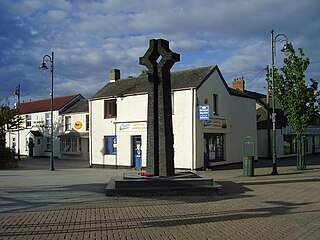
Caldicot is a market town and community in Monmouthshire, Wales,. The town is located between Chepstow and the city of Newport. The site adjoins the Caldicot Levels, on the north side of the Severn Estuary. The population of the town is around 11,000. It has a large school, Caldicot School, and is known for its medieval castle. The built-up area includes Portskewett. Caldicot had a population of 9,604 in 2011.
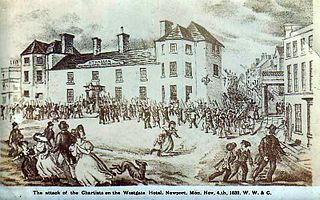
The Newport Rising was the last large-scale armed protest in Great Britain, seeking democracy and the right to vote with a secret ballot. On Monday 4 November 1839, approximately 4,000 Chartist sympathisers, under the leadership of John Frost, marched on the town of Newport, Monmouthshire. En route, some Newport chartists were arrested by police and held prisoner at the Westgate Hotel in central Newport. Marchers from industrial towns outside of Newport, including many coal-miners, some with home-made arms, were intent on liberating their fellow Chartists. On their demands that the protesters were freed, soldiers of the 45th Regiment of Foot, deployed in the protection of the police, were ordered to open fire at the crowd, turning the protest effectively into a pitched hand-to-hand battle. About 22 demonstrators were confirmed killed, whilst reports of perhaps a further 50 injured. 4 soldiers were reported as injured. Subsequently, the leaders of the march were convicted of treason and were sentenced to be hanged, drawn and quartered. The sentence was later commuted to transportation.

Llanmartin is a village and parish in the city of Newport, Wales.

Newport Unlimited was an Urban Regeneration Company created in 2003 to help counter the impacts of the decline in heavy industry and manufacturing in the city of Newport, South Wales. It was initially given a 10-year lifespan.
Pontnewynydd is a predominantly working class suburb of Pontypool, Torfaen, in Wales. It should not be confused with Pontnewydd in nearby Cwmbran.

The Kingsway Shopping Centre is an under-cover shopping centre in Newport city centre, Wales. The northern entrance is on John Frost Square adjoining the Friars Walk shopping and leisure complex. The east entrance is off Commercial Street and the west entrance off the A4042 Kingsway. The centre is a short walk from the high street shops of Commercial Street and High Street. Newport railway station is also a short walk away.
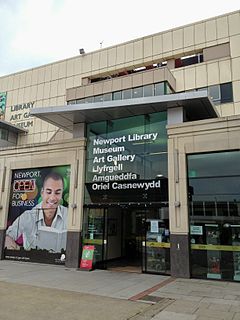
Newport Museum and Art Gallery is a museum, library and art gallery in the city of Newport, South Wales. It is located in Newport city centre on John Frost Square and is adjoined to the Kingsway Shopping Centre.
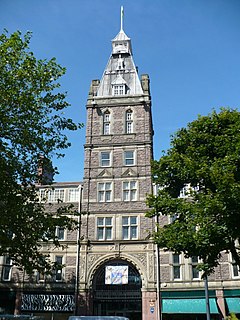
Newport city centre is traditionally regarded as the area of Newport, Wales bounded by the west bank of the River Usk, the George Street Bridge, the eastern flank of Stow Hill and the South Wales Main Line. Most of the city centre is contained within two conservation areas: the central area and the area around Lower Dock Street. Most of the city centre is located in the Stow Hill district.
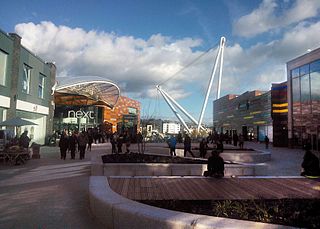
Friars Walk is a partially under-cover shopping centre and leisure complex in Newport city centre, South Wales. It has several levels and includes a range of high street shops, eateries, a cinema, a bowling alley and a soft play area. The complex is linked by the redeveloped John Frost Square to the Kingsway Shopping Centre, Newport Museum, Art Gallery and Central Library and Newport bus station. The complex is a short walk from the high street shops of Commercial Street and High Street. Newport railway station is also a short walk away.

Newport Central bus station is a bus terminus and interchange located in the city centre, Newport, South Wales. It is the largest road transport hub for public services in the county. It is situated on the Newport Market site and the adjacent Friars Walk site.

The Newport Centre is a leisure centre in Newport, South Wales. The Newport Centre is located in Newport city centre on the west bank of the River Usk adjacent to the Kingsway Shopping Centre. It holds events such as concerts, conferences and exhibitions. The centre hosted the Welsh Open snooker tournament from 2005 until 2014, as well as international business conferences and exhibitions. The centre also has suites overlooking the leisure pool and elsewhere; The Riverside Suite, Castle Room, Kingsway Suite, Usk Room, Treetops Suite, and the Emlyn Rooms.

The Shire Hall in Agincourt Square, Monmouth, Wales, is a prominent Grade I listed building in the town centre. It was built in 1724, and was formerly the centre for the Assize Courts and Quarter Sessions for Monmouthshire. In 1839/40, the court was the location of the trial of the Chartist leader John Frost and others for high treason for their part in the Newport Rising. The building was also used as a market place. The Shire Hall is owned by Monmouthshire County Council and has audiovisual guides for visitors to Courtroom 1. It is currently used as a Tourist Information Centre and as the offices for Monmouth Town Council, and is open to the public in part.
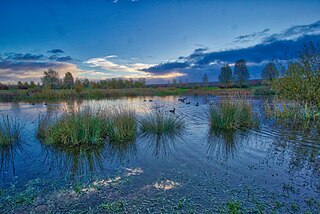
Glan Llyn (Lakeside) is the name of a mixed-use community development, in the east of Newport, south Wales on the heavy end of the former Llanwern steelworks, at the edge of the Caldicot Moors. The moors have a wealth of buried archaeology of international importance, including prehistoric and Roman landscapes which have been protected and preserved over the years by alluvial deposits.

The County Gaol, situated in North Parade, Monmouth, Wales, was Monmouthshire's main prison when it was opened in 1790. It served as the county jail of Monmouthshire and criminals or those who fell foul of the authorities were hanged here until the 1850s and some 3,000 people viewed the last hanging. The jail covered an area of about an acre, with a chapel, infirmary, living quarters and a treadmill. It was closed in 1869. In 1884 most of the building was demolished, and today nothing remains but the gatehouse which is a Grade II listed building. Within the gatehouse, there exists "a representation in coloured glass of the complete original buildings". It is one of 24 buildings on the Monmouth Heritage Trail.

The Chartist Mural was a mosaic mural designed by Kenneth Budd and created in 1978 in a pedestrian underpass in Newport, Wales. It commemorated the Newport Rising of 1839, in which an estimated 22 demonstrators were killed by troops. It was 115 feet (35 m) long and 13 feet (4.0 m) high. The mural was controversially destroyed in 2013 despite some public opposition and protests, before adjacent buildings were demolished to make way for the Friars Walk redevelopment.





















